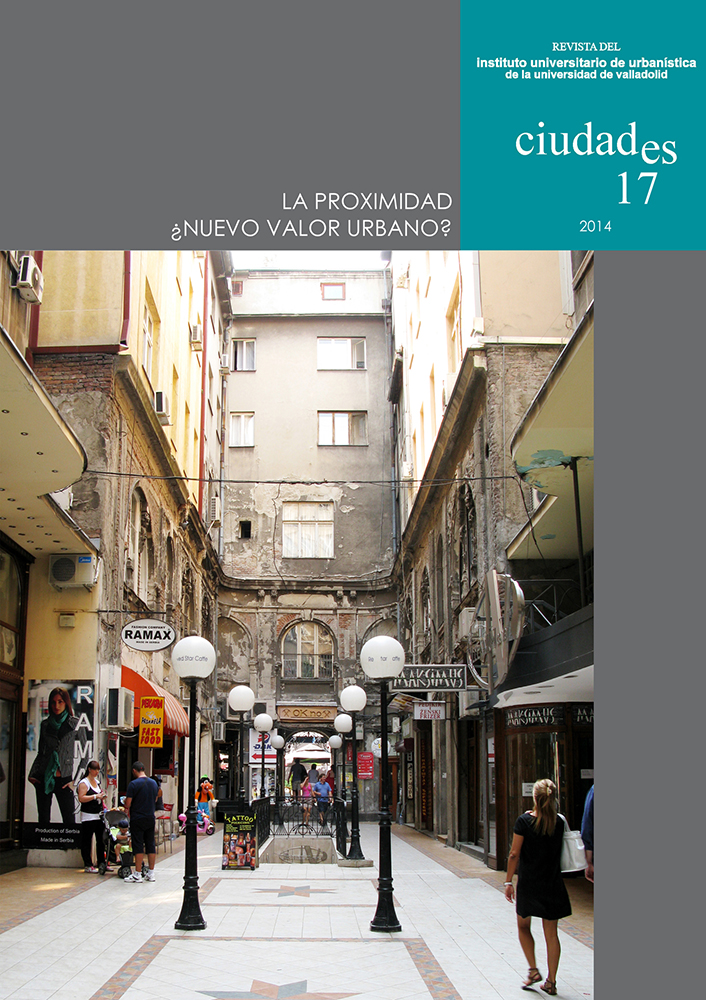In recent years, the reconsideration of urban values and the proposal for new overviews on city have produced the rise of the concept of proximity, as an essential perspective for the town’s construction. The overcoming of modern twentieth-century theses has resulted into the enhancement of neighbourhood scale, restrained urban development and compact structures. The common point underlying most of these new proposals is the return to nearness, either of persons, places, services or economic agents. A revelation, inherited from Jane Jacobs ideas, that has constituted one of the conceptual basis for so different authors as Richard Florida (2002) de Jan Gehl (2010), and Edward Glaeser (2011).
Human beings have always tended to gather themselves and group their daily and economic activities within heterogeneous urban areas (Baumont et al., 1998). Indeed, and as Jean M. Huriot (1998) states, the town is the perfect expression of the organized proximity, the so-called “dense diversity” by Levy (2011). That is, an area designed to facilitate and maximize human interactions at different levels, what enables to talk about physical, institutional, cognitive, social, temporary or affective nearness (Rallet, 1998).
Proximity is a polysemic and relational concept, which refers not only to an objective unit of the territory, but also to an attribute of the citizens. Concepts like connectivity, journey time or subjective conditions of movement determine if something is close or not, considering physical distance as one component more of the calculation (Brennan & Martin, 2012). The polysemy and complexity of the concept has allowed that, during the last years, diverse disciplines have attempted to analyse its effects from different focus and viewpoints.
In this way, architects, geographers and town planners have studied the impact produced by near and compact urban forms from the physical dimension’s side, as an alternative to the model of urbanism and mobility predominant during the last decades, characterized by disperse forms and automobile dependence. Thus, since Newman and Kenworthy (1989) confirmed that urban form had direct effects on the energetic consumption derived from transports, a lot of studies have tried to establish the advantages of living nearer one to each other, with regards to polluting emissions (de Nazelle et al., 2010) and fuel consumption (Mindali et al., 2004; Jabareen, 2013). These researches should be understood as one aspect more included in the general debate on sustainability and in the context of the role of transports on climatic change.
In the field of transports, there are also a significant number of works pointed to clear up how proximity, density or distances that we have to cover during our quotidian movements, are determining our choice of transport. Researches like Robert Cervero’s (1997) or Reid Ewing’s (2009) have focused on analysing in which way the physical factors of our environment –among them proximity– encourage us to use one mean of transport or another. Finally, territorial accessibility –measured on many occasions as the distance up to the services or the working place– has also drawn the attention of some authors, under the premise that proximity is the key to create more efficient and sustainable mobility behaviours (Miralles et al., 2014; McConville et al., 2011).
On the other hand, living near services or in high densities has also a social dimension (Lucas & Jones, 2012). Which are the advantages or disadvantages of living in dense and consolidated urban environments, from the citizens’ point of view? These aspects are being studied from the perspective of geography, sociology or politics, highlighting the proximity as a factor in social integration (Preston & Rajé, 2007). Vulnerable groups like the elderly or the disabled could compensate for their fewer potential of mobility by using proximity displacements more frequently, whenever the urban environment is favourable (Kerr et al., 2012). Even, the possibility of saving time gets especially important for population groups having complex agendas, as middle-aged women which combine paid-work and housework (Farber & Páez, 2011).
However, the study of social dimension of proximity hasn’t only focused on factors related with the access to resources, but also on aspects regarding people well-being. Some researches link proximity and population density to greater roots in the neighbourhood and more participation on community life (Jouffe, 2011), as well as a larger perception of safety (Dempsey et al., 2012).
Recently, several effects of proximity have awakened the interest on Public Health area. In the context of a society in which a sedentary lifestyle and the use of car prevail, proximity has beneficial effects on health, as it promotes active means of transport: to walk or to ride a bicycle. Walking friendly urban environments are achieved by a correct combination of design elements and distances reachable to be walked (Owen et al., 2007). Just because they are modes of transport provided with great positive externalities –in environmental, social and health terms– the concrete circumstances that motivate people to walk have been analysed as well. In this context the proximity between an origin and a destination becomes one of the key factors to choose the mode of transport (Southworth, 2005). Finally, in the same way, social participation of persons in their community increases in areas enabling the presence of the pedestrian (Richard et al., 2009), what constitutes an important aspect as a factor of inclusion and comfort.
Nevertheless, the largest tradition studying the consequences of proximity can be found on the spatial economy field. Alfred Marshall works had already analysed positive externalities generated by the concentration of business fabric (Clare, 2013). Gathered emplacement of companies increases productivity and the use of the same labour market and infrastructures (Torre, 1998). Following this line of thinking, distance affects the transmission of formal and informal information, making proximity into an essential element for innovation processes (Talen, 2008), which are so relevant in current economy. During the last years it has been validated that not only the companies are more productive when located nearer one from each other, but there is also a growing in the intellectual productivity of their members when these ones are gathered within an area (Glaeser, 2011). Like this, researches as Storper y Venables’ (2004), or Abel et al.’s (2012), have shown the relevant role of proximity when creating innovation and increasing richness and well-being.
The choice of transport to travel to the workplace and its relationship with the increase of richness has awakened the interest of economists as well. In this field, several studies point that proximity motivates the use of active transport, having an effect, in turn, on the better health of workers and the lower absences and time off work (Hendriksen et al., 2010).
Finally, we must not forget the effects of proximity on the town itself. When urban fabric facilitates proximity dynamics expressed by pedestrian activities, several effects on the town structure are generated (Gehl, 2010). On one hand, the presence of pedestrians has positive impacts on the commercial structure with regards to the streets’ small shops (Litman, 2011), and on the other hand, the perception of areas of higher urban quality (Leinberger & Alfonzo, 2012).
Journal «Ciudades» considers dealing with proximity as a new urban value. To do that, it compiles the contributions of a multidisciplinary group of authors that covers many of the fields of research in proximity in towns.
Barcelona, May 2014

